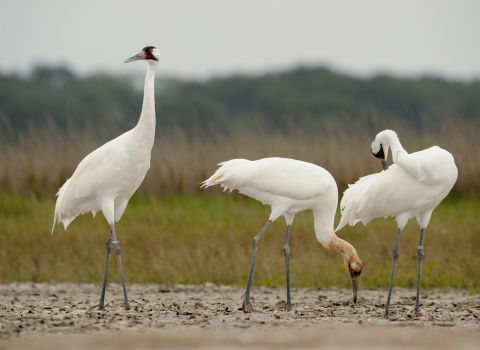The U.S. Fish and Wildlife Service today released two final Land Protection Plans allowing for the conservation of up to 150,000 acres of wildlife habitat in the Gulf Coast Prairies and Marshes ecoregion of Texas. The plans identify new limited acquisition boundaries for two Texas Coastal Bend refuges, Aransas National Wildlife Refuge and Big Boggy National Wildlife Refuge.
Investment in, and expansion of, the National Wildlife Refuge System furthers the Biden-Harris administration’s work to support community-driven efforts to conserve and restore the nation’s lands and waters through America the Beautiful initiative. Under Secretary Haaland’s leadership, the Department has also established four new Refuges.
The planning area is part of the Coastal Bend region of Texas which hosts high-quality habitat for several listed species under the Endangered Species Act. The new Land Protection Plans, which authorize the expansion and identify new acquisition boundaries for the refuges, include all or portions of Aransas, Calhoun, Goliad, Jackson, Matagorda, Refugio, San Patricio, and Victoria counties.
The Service worked with the National Wildlife Refuge Association, the Texas Parks and Wildlife Department and other partners to identify a conservation strategy and limited acquisition boundaries to enhance wildlife populations and protect habitat. The plans focus on conserving habitat for the endangered whooping crane, threatened Eastern black rail and endangered Attwater’s prairie chicken, as well as the mottled duck and other various wintering waterfowl. These protections may also help prevent the future listing of endangered or threatened species and support the delisting of listed species. In addition, newly acquired lands will be evaluated for potential recreational opportunities and appropriate public access.
"The approval of these plans is a significant step forward in conserving habitat for the benefit of wildlife and people on the Texas Gulf Coast," said Amy Lueders, the Service's Southwest Regional Director. "These plans prioritize areas that are important for the recovery of endangered whooping cranes and other imperiled wildlife species, with the added benefit of safeguarding natural spaces that benefit communities by providing protection from floods and storms as well as opportunities for hunting, fishing, wildlife viewing and ecotourism."
The Service develops Land Protection Plans to fully evaluate the establishment of new refuges as well as expansions to existing refuges. The approved expansion boundaries, which guide future refuge acquisitions, include priority areas where conservation efforts will have the highest anticipated benefit to wildlife and habitat. The Service works with willing sellers to expand conservation through fee title and easement acquisitions. These priorities all contribute to fulfilling the mission of the National Wildlife Refuge System.
Aransas National Wildlife Refuge was established in 1937 for migratory waterfowl and other wildlife and currently encompasses more than 115,000 acres of diverse habitat along the Texas Gulf Coast. With the approval of the new limited acquisition boundary, the refuge has the potential to nearly double in size by acquiring as many as 95,000 additional acres.
Big Boggy National Wildlife Refuge was established in 1983 to serve as an inviolate sanctuary for migratory birds and currently encompasses more than 4,526 acres of primarily salt marsh salt marsh
Salt marshes are found in tidal areas near the coast, where freshwater mixes with saltwater.
Learn more about salt marsh habitat along the Gulf Intracoastal Waterway. With the approval of the new limited acquisition boundary, the Refuge has the potential to undergo a significant expansion with the acquisition of up to 55,000 acres.
The final Land Protection Plan and approval documents can be accessed at ServCat using the plan codes 165843 for Aransas and 165844 for Big Boggy.
This year marks the 121st anniversary of the National Wildlife Refuge System - an unparalleled network of 571 national wildlife refuges, 38 wetland management districts and 5 marine national monuments. There is a national wildlife refuge national wildlife refuge
A national wildlife refuge is typically a contiguous area of land and water managed by the U.S. Fish and Wildlife Service for the conservation and, where appropriate, restoration of fish, wildlife and plant resources and their habitats for the benefit of present and future generations of Americans.
Learn more about national wildlife refuge within an hour’s drive of most major metropolitan areas – hosting some 67 million visits every year – almost all offering free admittance year-round. National wildlife refuges provide vital habitat for thousands of species and access to world-class recreation, from fishing, hunting and boating to nature watching, photography, and environmental education.



